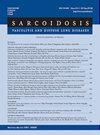老年特发性肺纤维化胸肌肌力变化的临床意义
IF 1.8
4区 医学
Q4 RESPIRATORY SYSTEM
Sarcoidosis, Vasculitis, and Diffuse Lung Diseases
Pub Date : 2022-03-31
DOI:10.36141/svdld.v39i1.12094
引用次数: 2
摘要
特发性肺纤维化(IPF)患者肌肉功能障碍的研究仅限于外周肌肉。然而,胸肌量减少是已知的,胸壁肌肉力量的恶化并不清楚。目的:评价胸壁胸肌力量,探讨肺活量测定、呼吸肌力量与胸肌力量的关系。方法:选取年龄、性别匹配的老年IPF患者(平均病程7.47±7.04年)和健康志愿者进行横断面研究。肺功能测试采用便携式肺活量计测量肺活量变量,气体分析仪测量一氧化碳扩散能力(DLCO)。采用口压仪测量最大吸气压(MIP)和呼气压(MEP)。采用改良的医学研究委员会呼吸困难量表(MMRC)来确定呼吸困难的严重程度。肩关节水平内收运动时,用手持式测力仪等距测量胸肌肌力。结果:共纳入IPF患者17例(男性9例,平均年龄69.06±3.94岁)和健康对照19例(男性10例,平均年龄70.95±4.99岁)。IPF患者的胸肌力量低于健康对照组(p<0.001)。胸肌力量与MIP (r=0.79, p<0.001)、MEP (r=0.81, p<0.001)、FEV1% (r=0.54, p=0.02)、FVC% (r=0.68, p<0.003)、DLCO (r=0.61, p=0.009)有显著相关。经多元线性回归分析,胸肌力量是FVC%的唯一独立预测因子(校正R2=0.37, p<0.05)。结论:IPF患者胸肌力量下降,并与肺功能有关。特别是胸肌力量可能对FVC%有重要影响。因此,我们认为这项测试应纳入常规胸部疾病和康复诊所。该试验已在美国国家医学图书馆临床试验登记处注册(https://clinicaltrials.gov,试验ID: NCT04803617)。本文章由计算机程序翻译,如有差异,请以英文原文为准。
Clinical significance of pectoralis muscle strength in elderly patients with idiopathic pulmonary fibrosis
Introduction: Investigations of muscle dysfunction in patients with idiopathic pulmonary fibrosis (IPF) are limited to peripheral muscles. However, decreased thoracic muscle mass is known and deterioration of chest wall muscle strength is not clear. Objective: The aims of the present study were to evaluate pectoralis muscle strength located on the chest wall and to investigate the relationship of spirometric measurements and respiratory muscle strength with pectoralis muscle strength. Methods: Elderly patient with IPF (mean disease duration 7.47±7.04 years) and the age-and sex-matched healthy volunteers were recruited in this cross-sectional study. The pulmonary function test was performed by a portable spirometer for spirometric variables and a gas analyzer for diffusing capacity for carbon monoxide (DLCO). Maximal inspiratory (MIP) and expiratory pressure (MEP) were measured with mouth pressure device. Modified Medical Research Council Dyspnea Scale (MMRC) was used to determined dyspnea severity. The pectoralis muscle strength was assessed isometrically during shoulder joint horizontal adduction movement with a handheld dynamometer. Results: A total of 17 patients with IPF (9 males, mean age 69.06±3.94 years) and 19 healthy controls (10 males, mean age 70.95 ±4.99 years) were included. Patients with IPF had lower pectoralis muscle strength than healthy controls (p<0.001). Significant relationships were found between pectoralis muscle strength and MIP (r=0.79, p<0.001), MEP (r=0.81, p<0.001), FEV1% (r=0.54, p=0.02), FVC% (r=0.68, p<0.003) and DLCO (r=0.61, p=0.009). With multiple linear regression analysis, pectoralis muscle strength was the only independent predictor of FVC% (adjusted R2=0.37, p<0.05). Conclusion: In patients with IPF, pectoralis muscle strength decreases and is associated with pulmonary function. In particular pectoralis muscle strength is likely to have an important impact on FVC%. Therefore, we consider that this test should be included routinely in chest diseases and rehabilitation clinics. The trial was registered U.S. National Library of Medicine clinical trial registry (https://clinicaltrials.gov, Trial ID: NCT04803617)
求助全文
通过发布文献求助,成功后即可免费获取论文全文。
去求助
来源期刊
CiteScore
2.20
自引率
6.20%
发文量
34
期刊介绍:
Sarcoidosis Vasculitis and Diffuse Lung Disease is a quarterly journal founded in 1984 by G. Rizzato. Now directed by R. Baughman (Cincinnati), P. Rottoli (Siena) and S. Tomassetti (Forlì), is the oldest and most prestigious Italian journal in such field.

 求助内容:
求助内容: 应助结果提醒方式:
应助结果提醒方式:


